KIA Rio 2005 2.G Owners Manual
Manufacturer: KIA, Model Year: 2005, Model line: Rio, Model: KIA Rio 2005 2.GPages: 238, PDF Size: 2.6 MB
Page 91 of 238

Automatic Transaxle OperationAll normal forward driving is done with the shift lever
in the D (Drive) position.
To move the shift lever from the P (Park) position, the
ignition switch must be in the ON position, the brake
pedal must be depressed, and the lock release button
must be depressed.
For smooth operation, depress the brake pedal when
shifting from N (Neutral) to a forward or Reverse gear.Driving Your Vehicle4-10
CAUTION
• Do not accelerate the engine in R (Reverse) or
any of the forward positions with the brakes
on.
When stopped on an upgrade, do not hold the
vehicle stationary with engine power. Use the
service brake or the parking brake.
Do not shift from N (Neutral) or P (Park) into
1 (1st), 2 (2nd), D (Drive) or R (Reverse) when
the engine is above idle speed.
1S2104005B
RIO ENG CNA 4.qxd 7/29/05 5:06 PM Page 10
Page 92 of 238
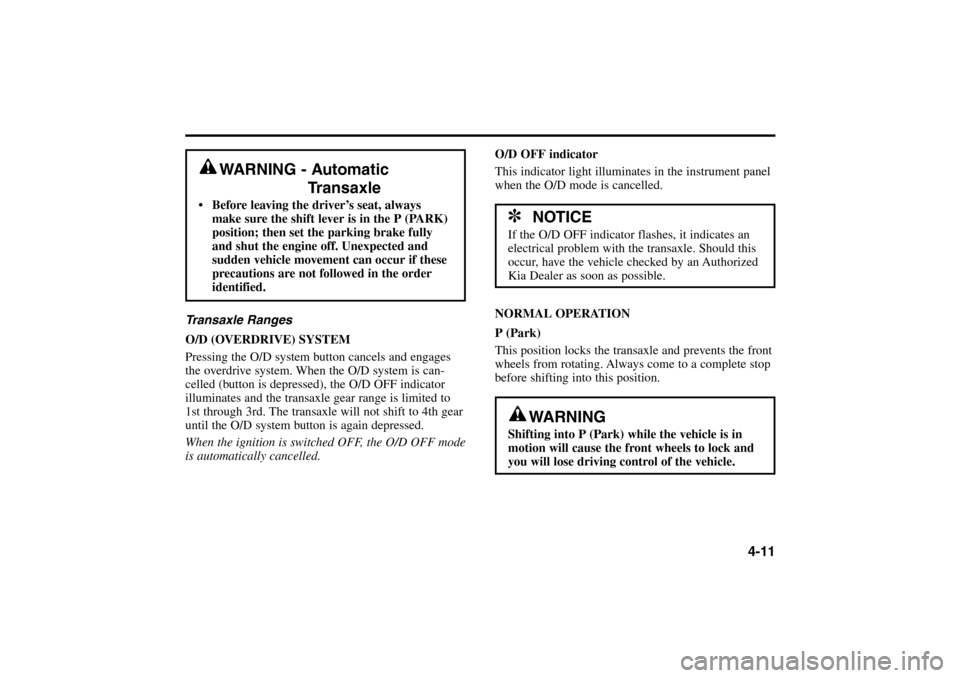
4-11
Transaxle Ranges
O/D (OVERDRIVE) SYSTEM
Pressing the O/D system button cancels and engages
the overdrive system. When the O/D system is can-
celled (button is depressed), the O/D OFF indicator
illuminates and the transaxle gear range is limited to
1st through 3rd. The transaxle will not shift to 4th gear
until the O/D system button is again depressed.
When the ignition is switched OFF, the O/D OFF mode
is automatically cancelled.
WARNING - Automatic
Transaxle
Before leaving the driver’s seat, always
make sure the shift lever is in the P (PARK)
position; then set the parking brake fully
and shut the engine off. Unexpected and
sudden vehicle movement can occur if these
precautions are not followed in the order
identified.
O/D OFF indicator
This indicator light illuminates in the instrument panel
when the O/D mode is cancelled.
NORMAL OPERATION
P (Park)
This position locks the transaxle and prevents the front
wheels from rotating. Always come to a complete stop
before shifting into this position.
✽
NOTICE
If the O/D OFF indicator flashes, it indicates an
electrical problem with the transaxle. Should this
occur, have the vehicle checked by an Authorized
Kia Dealer as soon as possible.
WARNING
Shifting into P (Park) while the vehicle is in
motion will cause the front wheels to lock and
you will lose driving control of the vehicle.
RIO ENG CNA 4.qxd 7/29/05 5:06 PM Page 11
Page 93 of 238
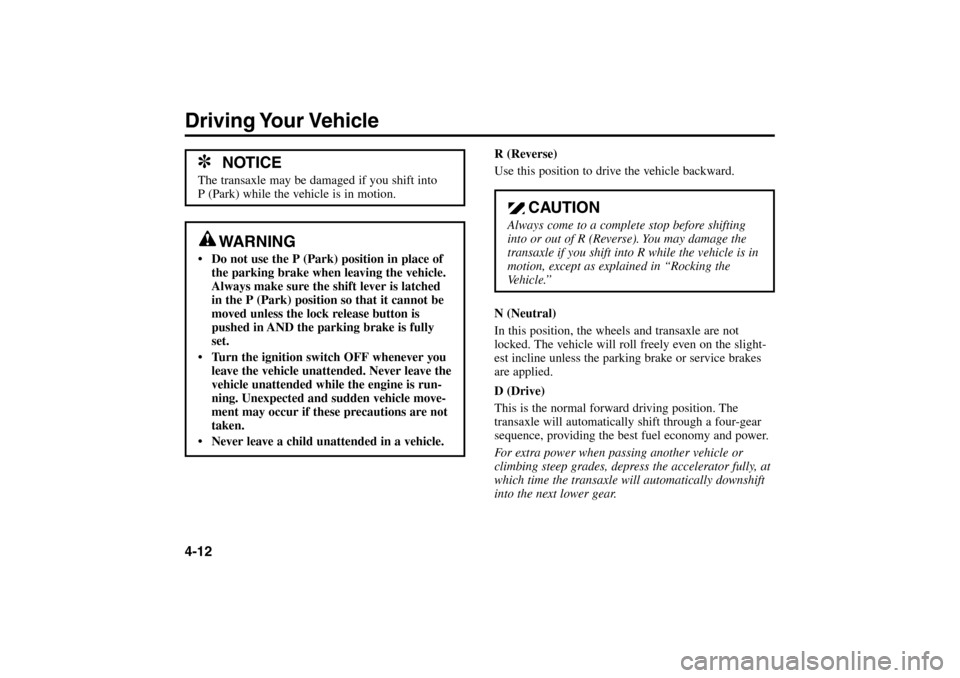
Driving Your Vehicle4-12
R (Reverse)
Use this position to drive the vehicle backward.
N (Neutral)
In this position, the wheels and transaxle are not
locked. The vehicle will roll freely even on the slight-
est incline unless the parking brake or service brakes
are applied.
D (Drive)
This is the normal forward driving position. The
transaxle will automatically shift through a four-gear
sequence, providing the best fuel economy and power.
For extra power when passing another vehicle or
climbing steep grades, depress the accelerator fully, at
which time the transaxle will automatically downshift
into the next lower gear.
CAUTION
Always come to a complete stop before shifting
into or out of R (Reverse). You may damage the
transaxle if you shift into R while the vehicle is in
motion, except as explained in “Rocking the
Ve h i c l e .’’
✽
NOTICE
The transaxle may be damaged if you shift into
P (Park) while the vehicle is in motion.
WARNING
Do not use the P (Park) position in place of
the parking brake when leaving the vehicle.
Always make sure the shift lever is latched
in the P (Park) position so that it cannot be
moved unless the lock release button is
pushed in AND the parking brake is fully
set.
Turn the ignition switch OFF whenever you
leave the vehicle unattended. Never leave the
vehicle unattended while the engine is run-
ning. Unexpected and sudden vehicle move-
ment may occur if these precautions are not
taken.
Never leave a child unattended in a vehicle.
RIO ENG CNA 4.qxd 7/29/05 5:06 PM Page 12
Page 94 of 238
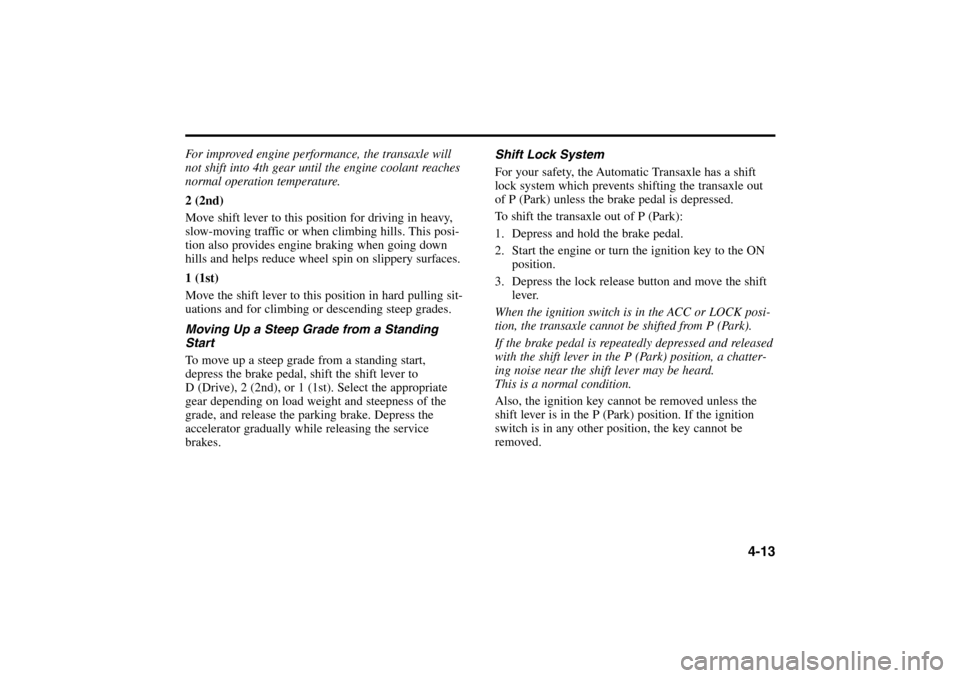
4-13
For improved engine performance, the transaxle will
not shift into 4th gear until the engine coolant reaches
normal operation temperature.
2 (2nd)
Move shift lever to this position for driving in heavy,
slow-moving traffic or when climbing hills. This posi-
tion also provides engine braking when going down
hills and helps reduce wheel spin on slippery surfaces.
1 (1st)
Move the shift lever to this position in hard pulling sit-
uations and for climbing or descending steep grades.
Moving Up a Steep Grade from a Standing
Start
To move up a steep grade from a standing start,
depress the brake pedal, shift the shift lever to
D (Drive), 2 (2nd), or 1 (1st). Select the appropriate
gear depending on load weight and steepness of the
grade, and release the parking brake. Depress the
accelerator gradually while releasing the service
brakes.Shift Lock System
For your safety, the Automatic Transaxle has a shift
lock system which prevents shifting the transaxle out
of P (Park) unless the brake pedal is depressed.
To shift the transaxle out of P (Park):
1. Depress and hold the brake pedal.
2. Start the engine or turn the ignition key to the ON
position.
3. Depress the lock release button and move the shift
lever.
When the ignition switch is in the ACC or LOCK posi-
tion, the transaxle cannot be shifted from P (Park).
If the brake pedal is repeatedly depressed and released
with the shift lever in the P (Park) position, a chatter-
ing noise near the shift lever may be heard.
This is a normal condition.
Also, the ignition key cannot be removed unless the
shift lever is in the P (Park) position. If the ignition
switch is in any other position, the key cannot be
removed.
RIO ENG CNA 4.qxd 7/29/05 5:06 PM Page 13
Page 95 of 238

Driving Your Vehicle4-14
2. Insert a screwdriver (cross or flat blade) into the
access hole, then depress the screwdriver.
AS2B04005A
Shift Lock Override
If the shift lever should fail to move from the
P (Park) position with the brake pedal depressed, con-
tinue depressing the brake, then do the following:
1. Carefully remove the cap covering the emergency
override access hole which is located on the right
side of the shift lever.
AS2B04004A
RIO ENG CNA 4.qxd 7/29/05 5:06 PM Page 14
Page 96 of 238
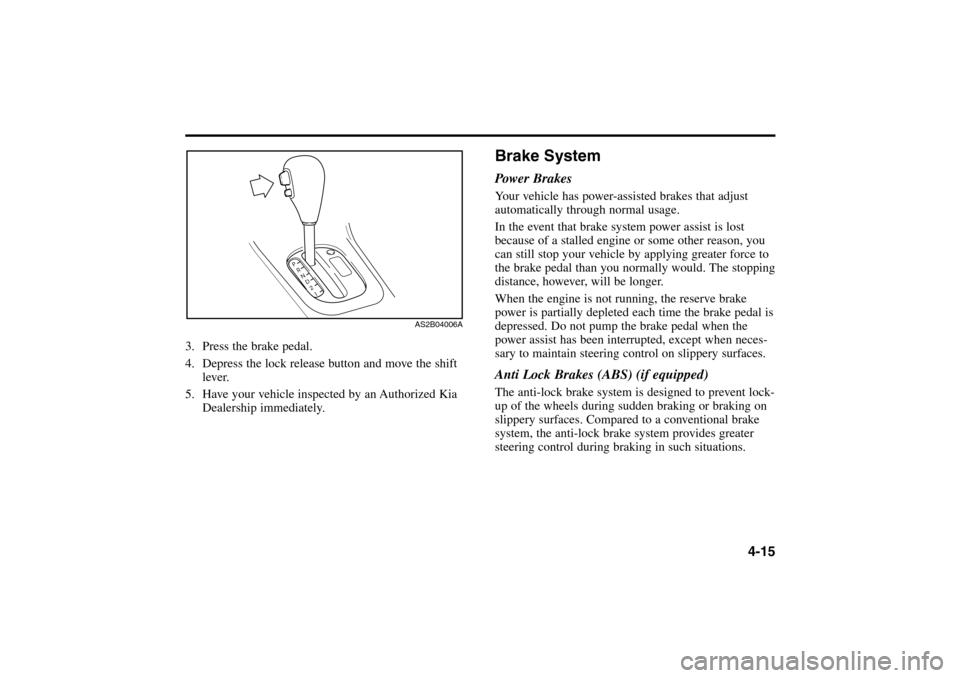
4-15
3. Press the brake pedal.
4. Depress the lock release button and move the shift
lever.
5. Have your vehicle inspected by an Authorized Kia
Dealership immediately.
AS2B04006A
Brake SystemPower BrakesYour vehicle has power-assisted brakes that adjust
automatically through normal usage.
In the event that brake system power assist is lost
because of a stalled engine or some other reason, you
can still stop your vehicle by applying greater force to
the brake pedal than you normally would. The stopping
distance, however, will be longer.
When the engine is not running, the reserve brake
power is partially depleted each time the brake pedal is
depressed. Do not pump the brake pedal when the
power assist has been interrupted, except when neces-
sary to maintain steering control on slippery surfaces.Anti Lock Brakes (ABS) (if equipped)The anti-lock brake system is designed to prevent lock-
up of the wheels during sudden braking or braking on
slippery surfaces. Compared to a conventional brake
system, the anti-lock brake system provides greater
steering control during braking in such situations.
RIO ENG CNA 4.qxd 7/29/05 5:06 PM Page 15
Page 97 of 238
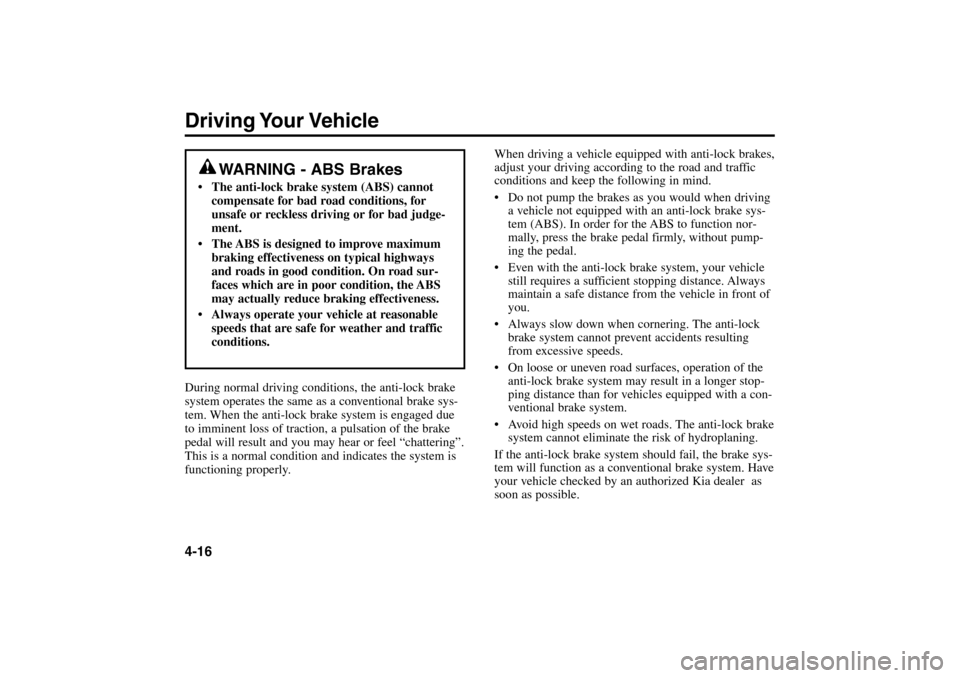
Driving Your Vehicle4-16
When driving a vehicle equipped with anti-lock brakes,
adjust your driving according to the road and traffic
conditions and keep the following in mind.
Do not pump the brakes as you would when driving
a vehicle not equipped with an anti-lock brake sys-
tem (ABS). In order for the ABS to function nor-
mally, press the brake pedal firmly, without pump-
ing the pedal.
Even with the anti-lock brake system, your vehicle
still requires a sufficient stopping distance. Always
maintain a safe distance from the vehicle in front of
you.
Always slow down when cornering. The anti-lock
brake system cannot prevent accidents resulting
from excessive speeds.
On loose or uneven road surfaces, operation of the
anti-lock brake system may result in a longer stop-
ping distance than for vehicles equipped with a con-
ventional brake system.
Avoid high speeds on wet roads. The anti-lock brake
system cannot eliminate the risk of hydroplaning.
If the anti-lock brake system should fail, the brake sys-
tem will function as a conventional brake system. Have
your vehicle checked by an authorized Kia dealer as
soon as possible. During normal driving conditions, the anti-lock brake
system operates the same as a conventional brake sys-
tem. When the anti-lock brake system is engaged due
to imminent loss of traction, a pulsation of the brake
pedal will result and you may hear or feel “chattering”.
This is a normal condition and indicates the system is
functioning properly.
WARNING - ABS Brakes
The anti-lock brake system (ABS) cannot
compensate for bad road conditions, for
unsafe or reckless driving or for bad judge-
ment.
The ABS is designed to improve maximum
braking effectiveness on typical highways
and roads in good condition. On road sur-
faces which are in poor condition, the ABS
may actually reduce braking effectiveness.
Always operate your vehicle at reasonable
speeds that are safe for weather and traffic
conditions.
RIO ENG CNA 4.qxd 7/29/05 5:06 PM Page 16
Page 98 of 238
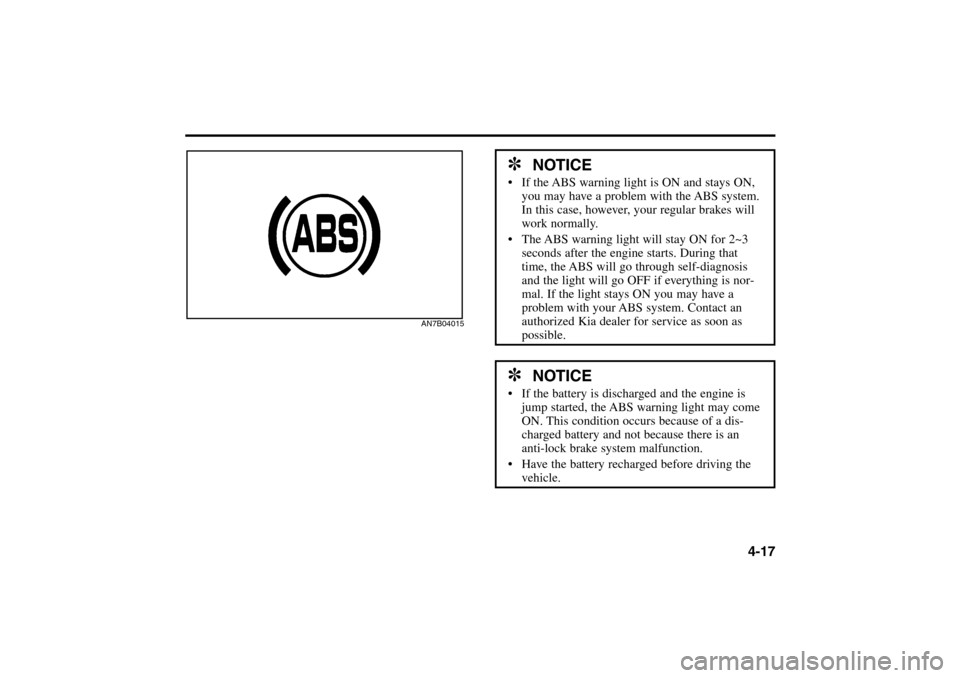
4-17
✽
NOTICE
If the ABS warning light is ON and stays ON,
you may have a problem with the ABS system.
In this case, however, your regular brakes will
work normally.
The ABS warning light will stay ON for 2~3
seconds after the engine starts. During that
time, the ABS will go through self-diagnosis
and the light will go OFF if everything is nor-
mal. If the light stays ON you may have a
problem with your ABS system. Contact an
authorized Kia dealer for service as soon as
possible.✽
NOTICE
If the battery is discharged and the engine is
jump started, the ABS warning light may come
ON. This condition occurs because of a dis-
charged battery and not because there is an
anti-lock brake system malfunction.
Have the battery recharged before driving the
vehicle.
AN7B04015
RIO ENG CNA 4.qxd 7/29/05 5:06 PM Page 17
Page 99 of 238
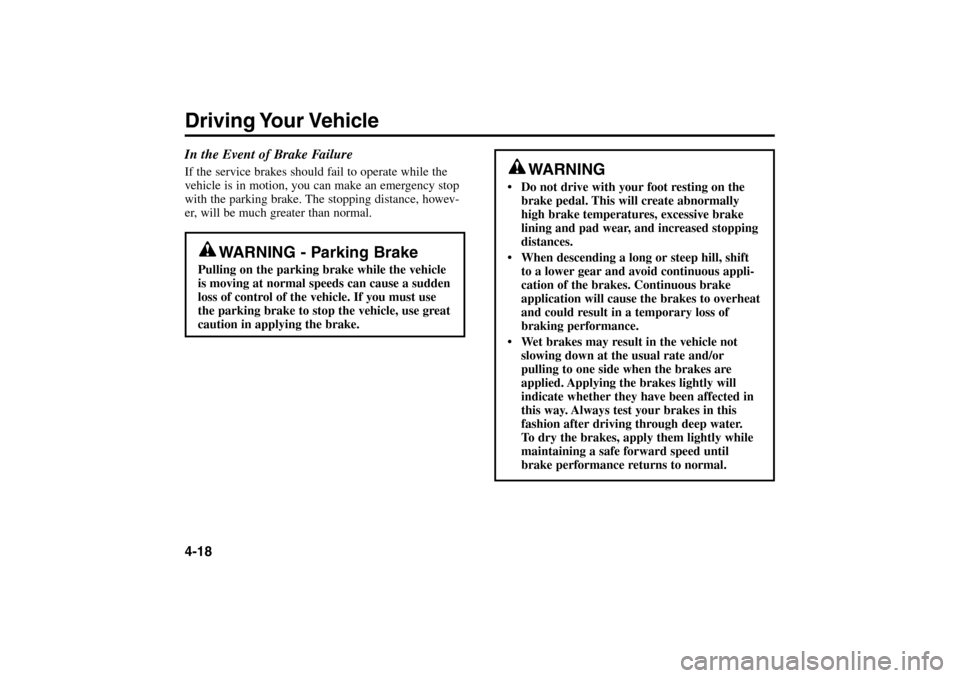
Driving Your Vehicle4-18 In the Event of Brake FailureIf the service brakes should fail to operate while the
vehicle is in motion, you can make an emergency stop
with the parking brake. The stopping distance, howev-
er, will be much greater than normal.
WARNING - Parking Brake
Pulling on the parking brake while the vehicle
is moving at normal speeds can cause a sudden
loss of control of the vehicle. If you must use
the parking brake to stop the vehicle, use great
caution in applying the brake.
WARNING
Do not drive with your foot resting on the
brake pedal. This will create abnormally
high brake temperatures, excessive brake
lining and pad wear, and increased stopping
distances.
When descending a long or steep hill, shift
to a lower gear and avoid continuous appli-
cation of the brakes. Continuous brake
application will cause the brakes to overheat
and could result in a temporary loss of
braking performance.
Wet brakes may result in the vehicle not
slowing down at the usual rate and/or
pulling to one side when the brakes are
applied. Applying the brakes lightly will
indicate whether they have been affected in
this way. Always test your brakes in this
fashion after driving through deep water.
To dry the brakes, apply them lightly while
maintaining a safe forward speed until
brake performance returns to normal.
RIO ENG CNA 4.qxd 7/29/05 5:06 PM Page 18
Page 100 of 238
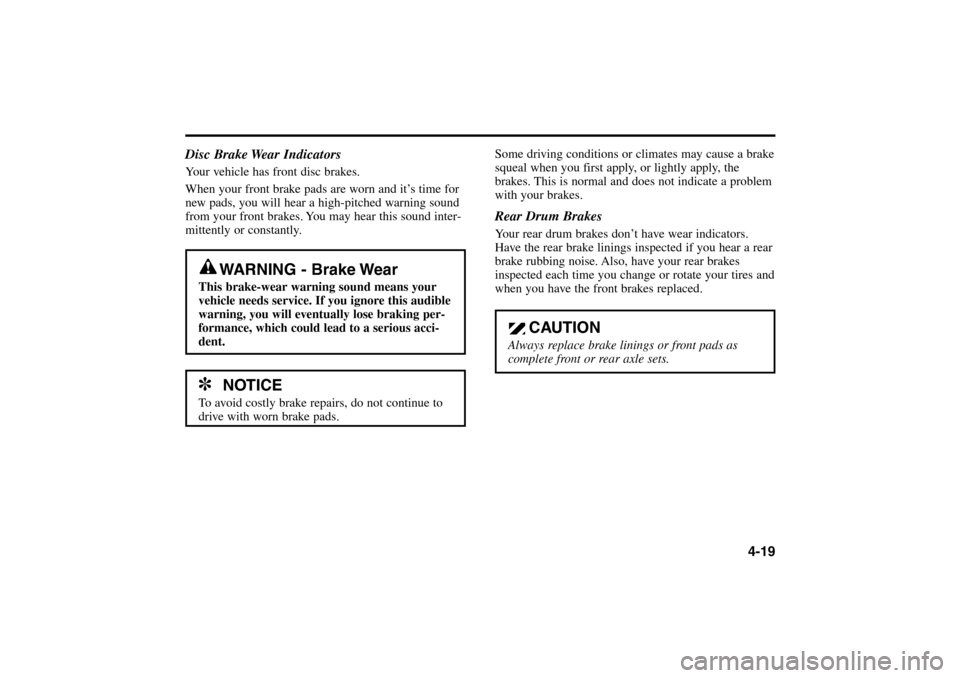
4-19 Disc Brake Wear Indicators
Your vehicle has front disc brakes.
When your front brake pads are worn and it’s time for
new pads, you will hear a high-pitched warning sound
from your front brakes. You may hear this sound inter-
mittently or constantly.Some driving conditions or climates may cause a brake
squeal when you first apply, or lightly apply, the
brakes. This is normal and does not indicate a problem
with your brakes.
Rear Drum BrakesYour rear drum brakes don’t have wear indicators.
Have the rear brake linings inspected if you hear a rear
brake rubbing noise. Also, have your rear brakes
inspected each time you change or rotate your tires and
when you have the front brakes replaced.
WARNING - Brake Wear
This brake-wear warning sound means your
vehicle needs service. If you ignore this audible
warning, you will eventually lose braking per-
formance, which could lead to a serious acci-
dent.✽
NOTICE
To avoid costly brake repairs, do not continue to
drive with worn brake pads.
CAUTION
Always replace brake linings or front pads as
complete front or rear axle sets.
RIO ENG CNA 4.qxd 7/29/05 5:06 PM Page 19